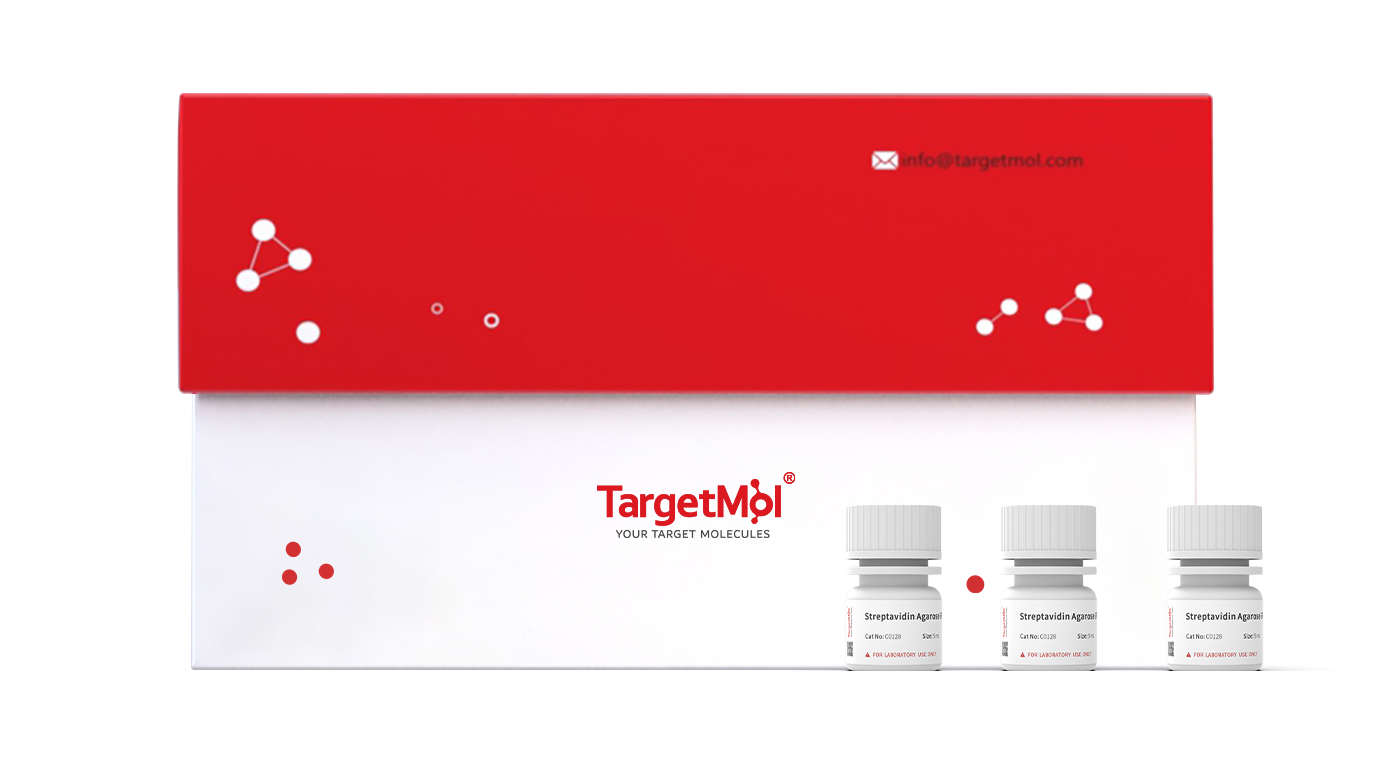 Your shopping cart is currently empty
Your shopping cart is currently empty


Streptavidin Agarose 6FF
TargetMol’s Streptavidin Agarose 6FF uses a highly cross-linked 6% agarose matrix, enabling it to withstand high flow rates and providing excellent chemical stability, making it particularly suitable for large-scale purification.
| Pack Size | Price | USA Warehouse | Global Warehouse | Quantity |
|---|---|---|---|---|
| 5 mL | $264 | - | In Stock |
 Product Information
Product Information
| Streptavidin Agarose 6FF | Specification |
|---|---|
| Matrix Spherical | Highly cross-linked 6% agarose beads |
| Bead Diameter | 45-165 μm |
| Ligand | Streptavidin |
| Binding Capacity | >200 nmol Biotin / mL resin |
| Maximum Pressure | 0.3 MPa, 3 bar |
| PH Stability Range | 4-9 |
| Storage Solution | 1×PBS (containing 20% ethanol) |
 Product Features
Product Features
- Excellent biotin-binding capacity
- Extremely low nonspecific adsorption
- Good stability
- Compatible with a wide range of experimental conditions
 Product Applications
Product Applications
- Purification of biotin or biotinylated proteins, antibodies, etc.
 Instructions
Instructions
1. Buffer Preparation
The following are commonly used buffer compositions. It is recommended to filter them with a 0.22 μm or 0.45 μm membrane filter before use:
A.Purification of biotin or biotinylated substances
1)Equilibration/Wash buffer: 20 mM NaH₂PO₄, 0.15 M NaCl, pH 7.4
2)Elution buffer: 8 M guanidine hydrochloride, pH 1.5
B.Purification of iminobiotin-tagged substances
1)Equilibration/Wash buffer: 50 mM ammonium carbonate, 0.5 M NaCl, pH 10.0
2)Elution buffer: 50 mM ammonium carbonate, 0.5 M NaCl, pH 4.0
2. Sample Preparation
1)Before loading onto the column, ensure that the ionic strength and pH of the sample solution are appropriate. Serum, ascites, or cell culture supernatants can be diluted with equilibration or wash buffer, or equilibrated through dialysis against the same buffer.
2)To reduce impurities, improve protein purification efficiency, and prevent column clogging, it is recommended to centrifuge the sample or filter it using a 0.22 μm or 0.45 μm membrane filter prior to loading.
3. Load of Streptavidin Agarose 6FF
A.Load the Gravity-flow Packed Column
1)Choose a gravity chromatography column of appropriate size. Insert the bottom frit, add an adequate amount of pure water to rinse the column tube and frit, then close the outlet.
2)Mix the Streptavidin Agarose 6FF thoroughly, then use a pipette tip to add an appropriate amount of the suspension into the gravity-flow column (the actual resin volume is half of the suspension volume). Open the outlet to drain the storage buffer.
3)Add an appropriate amount of pure water to rinse the resin. Once the liquid has drained completely by gravity, close the outlet.
4)Insert the pre-wetted top frit, ensuring there is no gap between the frit and the resin bed, and keep it level.
5)The gravity-flow packed column can be equilibrated directly with equilibration buffer. If not used immediately, add storage buffer and store at 2–8 °C.
B.Load the Medium-Pressure Chromatography Column
Streptavidin Agarose 6FF is widely used in industrial-scale purification, which often involves packing various medium-pressure chromatography columns. The following is a description of the column packing procedure. Before packing, calculate the column cross-sectional area based on its diameter and determine the required resin volume based on the desired packing height using the formula: V = 1.15πr²h (V: volume of resin required, in mL; 1.15: compression factor; r: radius of the column in cm; h: desired packing height in cm.)
Note: The volume of the suspension taken should be twice the volume of the resin, as the resin occupies only half of the suspension volume, the other half is storage buffer.
1)Rinse the bottom frit and fittings of the chromatography column with deionized water to ensure no air bubbles remain on the frit, then close the bottom outlet and leave 1–2 cm of deionized water at the bottom of the column.
2)Mix the resin suspension thoroughly, then carefully and continuously pour the suspension into the column. A glass rod can be used to guide the suspension along the column wall to minimize bubble formation.
3)If using a reservoir, immediately fill both the column and the reservoir with water. Place the distributor on the slurry surface and connect it to the pump, ensuring no bubbles are formed in the distributor or inlet tubing.
4)Open the column outlet and start the pump, allowing the buffer to flow through the column at a set flow rate. Begin with a slow flow rate and gradually increase to the final rate to avoid hydraulic shock to the resin bed and to ensure uniform packing. If the recommended pressure or flow rate cannot be reached, use the pump’s maximum flow rate, ideal packing can still be achieved.
Note: During subsequent chromatography runs, the flow rate should not exceed 75% of the maximum packing flow rate.
5)Once the resin bed height stabilizes, pass at least 3 column volumes of deionized water through the column at the final packing flow rate, and mark the bed height.
6)Turn off the pump and close the column outlet.
7)If using a reservoir, remove it and return the distributor to the column.
8)Lower the distributor to the marked bed height, allow packing buffer to enter the distributor, then lock the distributor fitting.
9)Finally, connect the packed column to the pump or chromatography system and begin equilibration. If necessary, readjust the distributor.
4. Sample Purification
A.Purification by Incubation
1)Based on the amount of sample to be purified, thoroughly mix the Streptavidin Agarose 6FF, then add an appropriate volume to a centrifuge tube. Centrifuge at 1000 rpm for 1 min and discard the supernatant; alternatively, add it directly to a gravity-flow column and allow the storage buffer to drain.
2)Add 5 volumes of equilibration buffer relative to the resin volume to wash the resin. Centrifuge at 1000 rpm for 1 min and discard the supernatant. If using a gravity-flow column, wash directly in the column and let the equilibration buffer drain completely. Repeat this step at least twice.
3)Add the sample, seal the centrifuge tube or gravity-flow column, and incubate at 4 °C with shaking for 2–4 hours, or at 37 °C for 30 minutes to 2 hours.
4)After incubation, centrifuge at 1000 rpm for 1 min and discard the supernatant, or collect the resin by filtration. Retain the supernatant as the flow-through sample for SDS-PAGE analysis.
5)Wash the resin with 5 volumes of wash buffer relative to the resin volume. Centrifuge at 1000 rpm for 1 min, or remove the supernatant by gravity flow (be careful not to aspirate the resin). Repeat 3–5 times. It is recommended to use a new centrifuge tube midway through.
6)Add 3–5 column volumes of elution buffer, incubate at room temperature for 5 minutes, centrifuge at 1000 rpm for 1 min, or collect the eluate by gravity flow. This step can be repeated 2–3 times.
B.Purification Using Gravity-flow Column
1)Equilibrate the packed Streptavidin Agarose 6FF gravity-flow column with 5 column volumes of equilibration buffer to ensure the resin is in the same buffer system as the target protein. Repeat 2–3 times.
2)Load the sample onto the equilibrated gravity-flow column, ensuring the sample remains in the column for at least 2 minutes to allow sufficient interaction with the resin. Collect the flow-through. The sample can be reapplied multiple times to improve binding efficiency.
3)Wash the column with 10–15 column volumes of wash buffer to remove nonspecifically bound proteins. Collect the wash fractions.
4)Elute with 5–10 column volumes of elution buffer, collecting the eluate in separate fractions. Collect one tube per column volume to monitor elution efficiency, ensuring complete recovery of the bound target protein with high purity and concentration.
C.Purification Using Medium-Pressure Chromatography Column
Once the Streptavidin Agarose 6FF is packed, purification can be performed using standard low- or medium-pressure chromatography systems.
1)Ensure the pump lines are filled with deionized water. Remove the top cap, connect the column to the chromatography system, open the bottom outlet, attach the pre-packed column to the system, and tighten the fittings.
2)Wash the column with 3–5 column volumes of deionized water to remove the storage buffer.
3)Equilibrate the column with at least 5 column volumes of equilibration buffer.
4)Load the sample using a pump or sample loop.
Note: If the sample has high viscosity, it may generate high back pressure even with small volumes. The sample volume should not exceed the binding capacity of the column. Large sample volumes may cause significant back pressure and make injection difficult.
5)Wash the column with wash buffer until the UV absorbance returns to a stable baseline (typically requires at least 10–15 column volumes).
6)Elute with 5–10 column volumes of elution buffer and collect the eluate, which contains the target protein. After elution, wash the column with 5–10 column volumes of equilibration buffer, then 5–10 column volumes of pure water, and finally 2 column volumes of 20% ethanol for storage at 2–8 °C.
5. SDS-PAGE Analysis Use SDS-PAGE to analyze samples obtained during purification (including flow-through fractions, wash fractions, and eluted fractions), as well as the original sample, to evaluate the purification efficiency.
6. Resin Cleaning
Streptavidin Agarose 6FF can be reused without regeneration, but the accumulation of nonspecific proteins and protein aggregation over time may lead to reduced flow rate and binding capacity. In such cases, the gel needs to be cleaned. 1)Removal of precipitates or denatured substances: Clean with 2 column volumes of 0.1 M NaOH, 6 M guanidine hydrochloride, or 8 M urea solution, followed immediately by 5 column volumes of PBS (pH 7.4). 2)Removal of nonspecific binding caused by hydrophobic adsorption: Clean with 3–4 column volumes of 70% ethanol or 2 column volumes of 1% Triton X-100, followed immediately by 5 column volumes of PBS (pH 7.4).
 Storage
Storage
Store at 4℃ for 2 years
 Precautions
Precautions
1.Avoid freezing this product.
2.During the experiment, samples should be handled at 4 °C or kept on ice.
3.This product is for R&D use only, not for diagnostic procedures, food, drug, household, or other uses.
4.It’s advisable to wear a lab coat and disposable glove.
 Instruction Manual
Instruction Manual
Keywords
| Size | Quantity | Unit Price | Amount | Operation |
|---|

Copyright © 2015-2025 TargetMol Chemicals Inc. All Rights Reserved.



